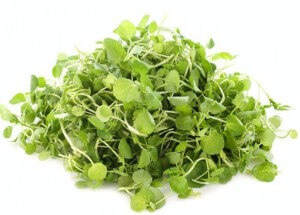
Watercress, now this is a food that we don’t talk about every day. However, this aquatic or semi-aquatic, fast growing perennial plant, which is native to Europe and Asia, is, in fact, one of the oldest leafy veggies consumed by mankind. This aromatic and peppery tasting plant, thrives in fresh spring water.
While its antiquity is interesting for sure, this plant has a lot more going for it than most people might think. It is a superfood in its own right and one that we should all consider adding to our diet.
In the United Kingdom, this plant was often eaten in the early 19th century as part of a healthy breakfast sandwich between bread. If you could not afford bread, you would eat it on its own in bunches. Because of this, it was sometimes called “poor man’s bread.”
The medicinal value of watercress can be traced way back in time. The Father of Medicine, Hippocrates was documented to have located his first hospital near a stream where watercress grew so that he would have plenty for his patients. Sixteenth century Greek soldiers consumed this leafy green before going into battle and herbalist Culpepper noted that it was a powerful blood cleanser.
After its early popularity, many people began to use watercress simply as a garnish due to its frilly appearance. It became a much underappreciated and rarely purchased item. However, recently, its value is being rediscovered through intense scientific research. Once again, watercress is climbing the popularity chart both in Europe and the United States
The nutrient profile of this water lover is indeed quite impressive. It contains over 15 different essential vitamins and minerals. It has spinach beat in iron, oranges beat for vitamin C and milk beat for calcium. This super aquatic plant is rich in phosphorous, potassium, iron, magnesium, beta-carotene, vitamins A, B1, B6, K and E , along with a host of powerful antioxidants.
Health Benefits
Watercress has a long list of documented health benefits, here are just a few.
- The American Journal of Clinical Nutrition notes that consuming watercress daily reduces DNA damage to blood cells, which is thought to be a precursor to cancer.
- Recent research also demonstrates the ability of key components in watercress to actually stop the brain from sending a signal to the body to flood cancerous tumors with blood. Without blood, the cancer cells cannot survive so they die.
- Lab studies show that consuming foods high in vitamin C can help maintain connective tissue and provide resistance to infectious agents. Just 100 mg of fresh watercress leaves provides more than 70% of the daily recommended allowance of vitamin C, a well known antioxidant that helps combat free radicals.
- Weight reduction programs that use whole foods often recommend watercress. It contains only 11 calories per 100 gram serving, making it extremely nutrient dense. Because it is so low in calories and has so many nutrients, it feeds the metabolism and provides ” low cost” energy which can promote weight loss.
- The raw leaves of watercress are pumped full of chlorophyll which contains digestive enzymes. These enzymes help the body absorb nutrients which the body requires for optimal performance.
- The rich calcium content of watercress helps to keep bones and teeth healthy. Keeping our bones healthy helps prevent osteoarthritis.
Shopping and Storing
 Most grocery stores stock watercress year round. Look for bunches that are perky with deep colored leaves. If it is fresh, it should have a peppery aroma when you rub it between your fingers.
Most grocery stores stock watercress year round. Look for bunches that are perky with deep colored leaves. If it is fresh, it should have a peppery aroma when you rub it between your fingers.
Wash the cress under clean water and soak it for about half an hour in water mixed with a little sea salt. This will take care of any parasite eggs and worms that grow in aquatic conditions.
If you cannot use the whole bunch right away, submerge the greens in water, and they will last for about 3 days in the fridge.
Using Watercress
- Use fresh cress in a mixed green salad
- Use leaves as a tasty addition to any sandwich
- Add to your favorite juice or green smoothie
- Steam and eat as you would spinach
- Use in soups or stews
Warnings:
- Only purchase watercress that has come from farms using fresh spring water
- Avoid eating watercress if you have a urinary tract stone.
- Because it is a member of the Brassica family, cress may contain goitrogens which interfere with thyroid hormone production. Do not eat watercress if you have or suspect you have a thyroid deficiency.
-The Alternative Daily
Sources:
http://www.medicalnewstoday.com/articles/63314.php
http://lifestoogood.net/watercress-the-forgotten-superfood/
http://www.diseaseproof.com/archives/cancer-anticancer-properties-of-watercress.html
http://www.nutrition-and-you.com/watercress.html

